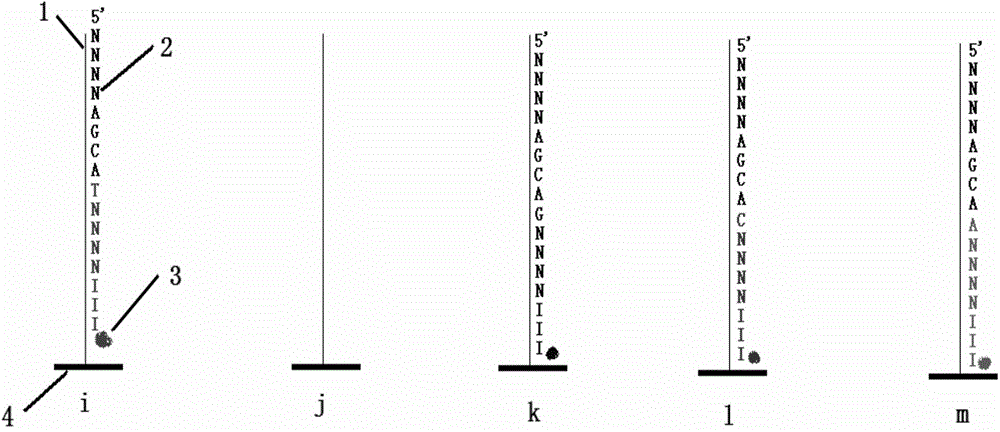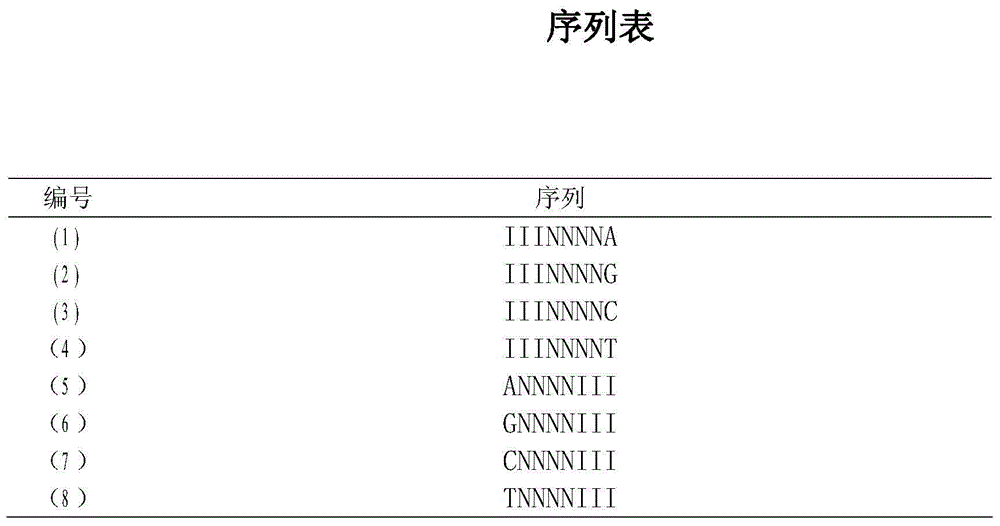Hybridization high-flux DNA (Deoxyribose Nucleic Acid) sequencing method based on ligase reaction
A DNA sequencing and ligase reaction technology, applied in the field of DNA sequencing, can solve the problems of large amount of probe synthesis, short hybridization probes, and high false positives, and solve false positives, high cost, low cost, and reliable accuracy. Effect
- Summary
- Abstract
- Description
- Claims
- Application Information
AI Technical Summary
Problems solved by technology
Method used
Image
Examples
Embodiment 1
[0034] A DNA sequence to be tested is amplified by conventional PCR and fixed on an aldehyde substrate to make an unknown DNA template. Prepare 256 DNA hybridization primers with a length of 8 bases, with four known bases at the 3' end and 4 random bases at the 5' end. The sequence characteristics of the hybridization primers can be expressed as 5'NNNNWXYZ3', where N is Any one of the four bases T, A, G, and C is not limited, or it can be replaced by a universal base I, and W, X, Y, and Z are all selected from T, A, G, and C. One base, such as 5'NNNNACGG3', 5'NNNNGACG3', etc., has 256 different sequences composed of WXYZ in hybridization primers.
[0035]1) Hybridization: The hybridization primer 5'NNNNGACG3' is hybridized with a fixed, unknown DNA template. Dissolve the hybridization primers at 100uM concentration in 1X hybridization solution, take an appropriate amount (submerge the template to be tested completely) and place the hybridization primers in the template to be ...
Embodiment 2
[0041] Example 2: Hybridization-Joint Fluorescent Labeled Sequencing Method Determination of Inclusion of the Whole Human Genome.
[0042] Cut the human genome with enzymes (or sonicate) into fragments with a size of 50-1000 bases, and connect these fragmented nucleic acid sequences with a pair of universal linkers (assumed to be 20 bases in length) under the action of ligase Base), the oligonucleotide sequence of one universal linker is completely complementary to the sequence of the amplification primer, and the oligonucleotide sequence of the other linker is the same as that of the sequencing positioning primer. The fragmented nucleic acid sequence connected by these tethers and the complementary sequence of the fixed linker are transferred to microbeads for emulsion parallel PCR reaction to amplify the fragmented whole human genome. These microbeads are immobilized on the plate substrate, and the human whole genome sequencing template is obtained by enzyme digestion or den...
Embodiment 3
[0044] Example 3: RNA expression profiling analysis based on ligase reaction-based hybrid high-throughput DNA sequencing method
[0045] 1. Extract the mRNA of normal cells and diseased cells respectively, and use magnetic beads to immobilize 30 T nucleotide chains to purify the mRNA so that the magnetic beads can absorb mRNA.
[0046] 2. Reverse transcribe into cDNA, and use RNaseH, DNA polymerase, etc. to synthesize the second strand.
[0047] 3. Digest the product of step 2 with an endonuclease (CSau 3AI) that recognizes four bases. Wash the magnetic beads with binding buffer.
[0048] 4. Add linker primer A (with endonuclease Acu I recognition site on the primer) under the action of ligase.
[0049] 5. Digest the product of step 4 with Acu I. A cDNA library of adapter primer A followed by 16 unknown sequences to be tested was obtained.
[0050] 6. Add another linker primer B. Amplification was then performed using emulsion PCR.
[0051] 7. The amplified product is im...
PUM
 Login to View More
Login to View More Abstract
Description
Claims
Application Information
 Login to View More
Login to View More - R&D
- Intellectual Property
- Life Sciences
- Materials
- Tech Scout
- Unparalleled Data Quality
- Higher Quality Content
- 60% Fewer Hallucinations
Browse by: Latest US Patents, China's latest patents, Technical Efficacy Thesaurus, Application Domain, Technology Topic, Popular Technical Reports.
© 2025 PatSnap. All rights reserved.Legal|Privacy policy|Modern Slavery Act Transparency Statement|Sitemap|About US| Contact US: help@patsnap.com



